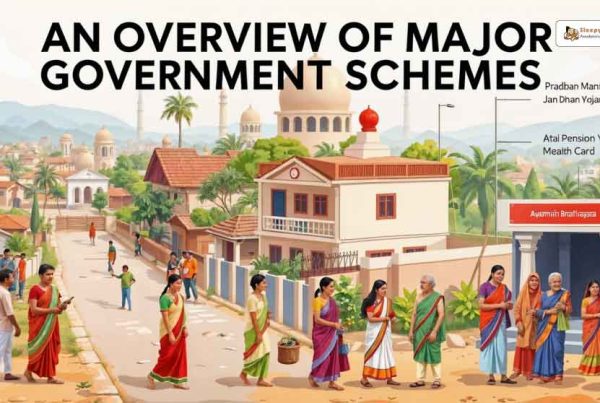The Keshavnanda Bharti case is one of the most significant rulings in the history of Indian constitutional law. Decided in 1973, this landmark judgment has had a lasting impact on the interpretation and amendment of the Indian Constitution. The case introduced the Doctrine of Basic Structure, a principle that continues to shape the legal landscape of India.
Key Takeaways
- The Keshavnanda Bharti case established the Doctrine of Basic Structure, which limits the power of Parliament to amend the Constitution.
- The Supreme Court’s ruling ensured that certain fundamental features of the Constitution cannot be altered by amendments.
- The case was decided by the largest bench in the history of the Supreme Court of India, consisting of 13 judges.
- The judgment balanced the need for constitutional amendments with the protection of fundamental rights.
- The ruling has influenced numerous subsequent cases and remains a cornerstone of Indian constitutional law.
Background and Context of the Keshavnanda Bharti Case
Historical Background
The roots of the Keshavnanda Bharti case trace back to 1951, soon after India adopted its Constitution. The central question was about the extent of Parliament’s power to amend the Constitution. This debate intensified over the years, especially concerning whether fundamental rights could be altered. The case itself emerged when Swami Keshavnanda Bharti, a religious leader, challenged the Kerala land reforms legislation in 1970, which imposed restrictions on the management of religious property.
Key Players Involved
Swami Keshavnanda Bharti was the main petitioner in this landmark case. He was the head of a Hindu monastery in Kerala. The respondents included the State of Kerala and the Union of India. The case also saw the involvement of prominent lawyers and judges, making it a significant event in Indian legal history.
Initial Legal Challenges
The initial legal challenge was against the Kerala government’s land reforms, which aimed to redistribute land to the landless. Swami Keshavnanda Bharti argued that these reforms violated his fundamental rights. This case quickly escalated to question the broader issue of whether Parliament could amend any part of the Constitution, including fundamental rights. This set the stage for a historic legal battle.
The Constitutional Amendments Leading to the Case
Amendments in Question
The Keshavnanda Bharti case revolved around the validity of the 24th, 25th, and 29th Constitutional Amendments. These amendments were challenged by the petitioner, who argued that they directly violated his fundamental rights. The Supreme Court had to decide whether these amendments were constitutionally valid.
Government’s Stance
The government argued that Parliament had the power to amend any part of the Constitution, including fundamental rights. They believed that these amendments were necessary for the country’s progress and development. The government maintained that the amendments did not alter the basic structure of the Constitution.
Opposition’s Arguments
The opposition contended that Parliament’s power to amend the Constitution was not unlimited. They argued that certain fundamental principles, such as the basic structure, could not be altered. The opposition feared that allowing such amendments would undermine the core values of the Constitution and erode citizens’ fundamental rights.
The case raised critical questions about the extent of Parliament’s power to amend the Constitution and the protection of fundamental rights. The Supreme Court’s decision would have far-reaching implications for the future of Indian constitutional law.
The Supreme Court’s Bench and Proceedings
Composition of the Bench
The Keshavnanda Bharti case was heard by the largest bench ever in the history of the Supreme Court of India, consisting of 13 judges. This was a unique and significant event, as such a large bench was assembled to deliberate on the case. The bench included some of the most prominent judges of the time, who were tasked with making a decision that would have a lasting impact on the Indian Constitution.
Duration and Key Hearings
The proceedings of the Keshavnanda Bharti case spanned an extensive period of 68 days, making it one of the longest hearings in the history of the Supreme Court. During this time, the court heard numerous arguments and counterarguments from both sides. The length of the hearings underscored the complexity and importance of the issues at hand.
Major Legal Arguments Presented
Several major legal arguments were presented during the hearings. One of the key points of contention was whether the Parliament had the power to amend any part of the Constitution, including the fundamental rights. The government argued that the Parliament had unlimited power to amend the Constitution under Article 368. On the other hand, the opposition contended that there were inherent limitations to this power, and that the basic structure of the Constitution could not be altered. This debate was central to the case and formed the basis of the final judgment.
The Keshavnanda Bharti case highlighted the critical role of the Supreme Court in safeguarding the Constitution and ensuring that its basic structure remains intact.
The Supreme Court’s decision in this case continues to influence constitutional law in India, emphasizing the importance of judicial review and the protection of fundamental rights.
The Doctrine of Basic Structure
Definition and Origin
The Doctrine of Basic Structure is a principle in Indian constitutional law. It states that while the Parliament can amend the Constitution, it cannot alter its basic structure. This doctrine was first recognized in the landmark Keshavnanda Bharti case. The Supreme Court of India developed this doctrine to ensure that certain fundamental aspects of the Constitution remain unchanged.
Application in the Case
In the Keshavnanda Bharti case, the Supreme Court applied the Doctrine of Basic Structure to evaluate the validity of constitutional amendments. The court held that any amendment that damages or destroys the basic structure of the Constitution is invalid. This decision was crucial in maintaining the core principles of the Indian Constitution.
Implications for Future Amendments
The Doctrine of Basic Structure has significant implications for future constitutional amendments. It acts as a safeguard against any changes that could undermine the Constitution’s fundamental values. This doctrine ensures that the essence of the Constitution remains intact, even as it evolves over time. The doctrine is recognized in India, Bangladesh, Pakistan, and Uganda, highlighting its importance in constitutional law across multiple countries.
Key Judgements and Opinions
The Keshavnanda Bharti case is one of the most significant rulings in Indian constitutional history. The Supreme Court’s decision was delivered by a 13-judge bench, which is the largest bench ever constituted in the history of the court. The verdict was a close call, with a majority of 7:6, highlighting the deep divisions among the judges on the issues at hand. This landmark judgement introduced the concept of the basic structure of the Constitution, which means that certain fundamental features of the Constitution cannot be altered by any amendment.
Majority Opinion
The majority opinion, delivered by Chief Justice S.M. Sikri and six other judges, held that while Parliament has wide powers to amend the Constitution, it cannot alter its basic structure. This means that any amendment that seeks to change the essential features of the Constitution, such as its democratic framework, secular character, or the separation of powers, would be invalid. The majority emphasized that the Constitution is a living document and must be interpreted in a manner that preserves its core principles.
Dissenting Opinions
The dissenting judges, led by Justice A.N. Ray, argued that Parliament’s power to amend the Constitution should be absolute and unrestricted. They believed that imposing limitations on this power would undermine the sovereignty of Parliament and hinder its ability to respond to changing needs and circumstances. The dissenters were of the view that the judiciary should not interfere with the legislative process and that any issues arising from constitutional amendments should be resolved through political means rather than judicial review.
Legal Reasoning Behind the Verdict
The legal reasoning behind the majority’s decision was rooted in the belief that the Constitution is not just a legal document but a social contract that reflects the aspirations and values of the people. The judges argued that allowing Parliament to alter the basic structure would be akin to allowing it to rewrite the social contract, which could lead to the erosion of fundamental rights and freedoms. The majority also pointed to the historical context in which the Constitution was framed, noting that its drafters intended for certain core principles to remain inviolable.
The Keshavnanda Bharti case set a precedent that continues to influence constitutional law in India. It established the judiciary as a guardian of the Constitution, ensuring that its fundamental features are preserved for future generations.
Impact on Indian Constitutional Law
Immediate Legal Consequences
The Keshavnanda Bharti case had immediate legal consequences. The Supreme Court’s decision established that while Parliament has the power to amend the Constitution, it cannot alter its basic structure. This ruling provided a safeguard against potential misuse of power by the legislature.
Long-term Constitutional Changes
Over time, the case led to significant long-term changes in the Indian Constitution. The doctrine of basic structure became a cornerstone of constitutional law, ensuring that certain fundamental principles remain inviolable. This doctrine has been invoked in numerous subsequent cases to protect the integrity of the Constitution.
Influence on Subsequent Cases
The impact of the Keshavnanda Bharti case extended to many other landmark cases. For instance, in Minerva Mills v. Union of India (1980), the Supreme Court struck down a constitutional amendment that expanded Article 31C, stating it “destroys” the harmony between parts of the Constitution. This demonstrates the enduring influence of the basic structure doctrine in maintaining constitutional balance.
Criticism and Controversies
The Keshavnanda Bharti case, while landmark, was not without its share of criticism and controversies. Many legal scholars and political analysts have debated the implications and reasoning behind the verdict.
Critiques of the Verdict
One of the main points of contention was the introduction of the Basic Structure Doctrine. Critics argued that this doctrine was too vague and gave the judiciary excessive power to overrule constitutional amendments. This led to concerns about the balance of power between the judiciary and the legislature.
Political Reactions
The political landscape was significantly affected by the verdict. The ruling government at the time felt that the Supreme Court’s decision undermined its authority to amend the Constitution. This created a tense relationship between the judiciary and the executive branches of government.
Public Opinion
Public opinion was divided. Some hailed the decision as a victory for democracy and a safeguard against potential government overreach. Others believed that it set a dangerous precedent by allowing the judiciary to have the final say on constitutional matters.
The Keshavnanda Bharti case remains a pivotal moment in Indian constitutional history, sparking debates that continue to this day.
Comparative Analysis with Other Landmark Cases
The Golaknath case, decided in 1967, was a significant precursor to the Keshavnanda Bharti case. In Golaknath, the Supreme Court ruled that Parliament could not amend fundamental rights. This decision set the stage for the later debate on the extent of Parliament’s power to amend the Constitution. The Keshavnanda Bharti case revisited this issue, ultimately leading to the establishment of the Basic Structure Doctrine, which allows for amendments but not to the core principles of the Constitution.
The Indira Gandhi v. Raj Narain case in 1975 further tested the limits of constitutional amendments. This case arose from the challenge to Indira Gandhi’s election victory, which was initially overturned by the Allahabad High Court. The Supreme Court’s decision in this case reinforced the Basic Structure Doctrine established in Keshavnanda Bharti, emphasizing that even during emergencies, the core principles of the Constitution cannot be altered. This case highlighted the judiciary’s role in safeguarding democratic processes and ensuring that constitutional integrity is maintained.
The Keshavnanda Bharti case, along with the Golaknath and Indira Gandhi cases, underscores the importance of judicial review in India. These cases collectively illustrate how the judiciary acts as a check on legislative and executive powers, ensuring that the Constitution’s fundamental principles are preserved. The Basic Structure Doctrine, born out of these landmark cases, remains a cornerstone of Indian constitutional law, guiding future amendments and protecting the Constitution’s core values.
Legacy of the Keshavnanda Bharti Case
The Keshavnanda Bharti case left a lasting mark on Indian constitutional law. One of the most important outcomes was the establishment of the Basic Structure Doctrine. This doctrine ensures that certain fundamental aspects of the Constitution cannot be altered by amendments, safeguarding the core principles of the nation.
Enduring Legal Principles
The case reinforced the idea that while the Constitution can be amended, its essential features must remain intact. This principle has been a cornerstone in protecting the democratic framework of India.
Impact on Judicial Review
The verdict empowered the judiciary to review and, if necessary, strike down constitutional amendments that threaten the basic structure. This has strengthened the role of the judiciary in maintaining the balance of power among the branches of government.
Continued Relevance in Modern Times
Even today, the principles established in this case are used to evaluate new amendments and laws. The case remains a reference point for debates on constitutional changes and the limits of legislative power.
The Keshavnanda Bharti case is a testament to the judiciary’s role in protecting the Constitution’s core values, ensuring that the essence of democracy is preserved for future generations.
The Role of the Judiciary in Safeguarding the Constitution
The judiciary plays a crucial role in protecting the Constitution. It ensures that the fundamental principles and ideas of the Constitution are upheld. This includes safeguarding the separation of powers, the fundamental rights of citizens, and the rule of law. The judiciary acts as a check on the other branches of government, preventing any arbitrary constitutional amendments that could compromise the essential ideas of the Constitution.
Judicial Activism vs. Judicial Restraint
Judicial activism refers to the proactive role of the judiciary in interpreting the Constitution and laws to address social issues. On the other hand, judicial restraint emphasizes the limited role of judges, urging them to defer to the decisions made by the legislative and executive branches. Both approaches have their merits and drawbacks, and the judiciary must strike a balance between the two to effectively safeguard the Constitution.
Balance of Powers
The judiciary ensures a balance of powers among the different branches of government. By exercising judicial review, the judiciary can invalidate laws and actions that violate the Constitution. This doctrine is well-embedded in India, with clear constitutional backing. The judiciary’s role in overseeing the actions of the legislature and executive is vital for maintaining the integrity of the Constitution.
Future Challenges
The judiciary will continue to face challenges in safeguarding the Constitution. As society evolves, new legal and constitutional issues will arise. The judiciary must adapt to these changes while ensuring that the core principles of the Constitution are not compromised. This requires a careful analysis of multifarious aspects and a commitment to preserving the spirit of Indian democracy.
The judiciary plays a crucial role in protecting our Constitution. It ensures that laws are fair and just, and that everyone’s rights are respected. Want to learn more about how the judiciary safeguards our freedoms? Visit our website for detailed articles and resources.
Conclusion
The Kesavananda Bharti case stands as a cornerstone in Indian constitutional law. It clarified the extent of Parliament’s power to amend the Constitution, ensuring that the basic structure remains untouched. This landmark ruling has had a lasting impact, shaping the balance between the need for change and the preservation of core principles. The case not only reinforced the judiciary’s role in safeguarding the Constitution but also highlighted the importance of protecting fundamental rights. As a result, the Kesavananda Bharti case continues to be a pivotal reference point in discussions about constitutional amendments and the enduring strength of India’s democratic framework.
Frequently Asked Questions
What was the Kesavananda Bharti case about?
The Kesavananda Bharti case was about whether the Indian Parliament had the power to amend the Constitution without altering its basic structure. It was a landmark case that established the doctrine of basic structure.
Why is the Kesavananda Bharti case considered a landmark case?
The Kesavananda Bharti case is considered a landmark because it set the precedent that while Parliament can amend the Constitution, it cannot change its basic structure. This decision protects the core principles of the Constitution.
Who were the key players in the Kesavananda Bharti case?
The key players in the Kesavananda Bharti case included Kesavananda Bharti, who challenged the amendments, and the Indian government, which defended its right to amend the Constitution. The case was decided by a 13-judge bench of the Supreme Court.
What is the doctrine of basic structure?
The doctrine of basic structure is a judicial principle that certain fundamental features of the Constitution cannot be altered by amendments. It was established by the Supreme Court in the Kesavananda Bharti case.
What were the main arguments in the Kesavananda Bharti case?
The main arguments in the Kesavananda Bharti case were whether Parliament had unlimited power to amend the Constitution and whether certain amendments violated the basic structure of the Constitution.
What was the Supreme Court’s verdict in the Kesavananda Bharti case?
The Supreme Court’s verdict in the Kesavananda Bharti case was that Parliament could amend any part of the Constitution as long as it did not alter its basic structure. The verdict was decided by a narrow 7-6 majority.
How has the Kesavananda Bharti case impacted Indian constitutional law?
The Kesavananda Bharti case has had a lasting impact on Indian constitutional law by establishing that the basic structure of the Constitution cannot be altered. This has influenced many subsequent cases and amendments.
What were the immediate consequences of the Kesavananda Bharti verdict?
The immediate consequences of the Kesavananda Bharti verdict were that it limited Parliament’s power to amend the Constitution, ensuring that fundamental principles like democracy and the rule of law could not be changed.







